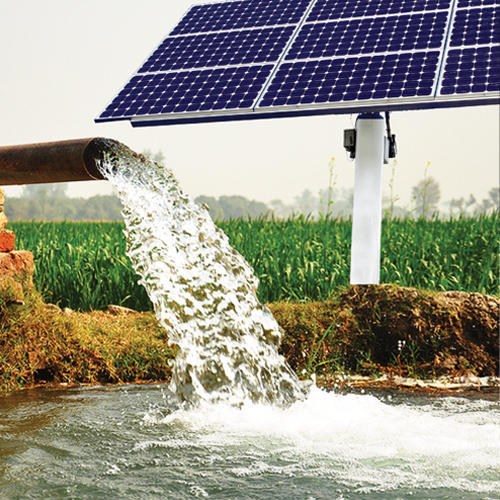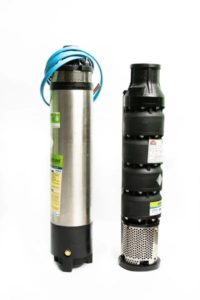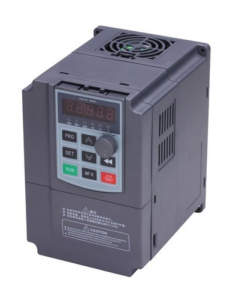
A clean and consistent supply of water is one of the basic needs of every individual residing on this planet. However owing to the ever-growing population, almost one-fifth of the total world’s population are in scarcity. In a situation like this, solar pump, which uses solar energy system is a very efficient and environmentally friendly option to supply water in remote locations. It is also economically viable. These solar pumping systems are set to replace the modern electric pumps as it has various benefits related to the socio-economic factors
What is a solar pump?
A solar pump or solar photovoltaic water pumping set is a system powered by solar energy. It works just like the traditional electric pump but in this case, solar pumping set uses the energy of the sun instead of burning fossil fuels to extract water from the ground and supply to respective regions.
The solar pumping sets mainly comprise of a solar panel, water pump, motor, and controller. The solar water pump set connects with the solar panel through a solar pump controller. When sunlight falls on the solar panel it generates electricity, which prompts the solar pump to start lifting the water from the ground. No conventional electricity is required to run this pump. Places or regions where grid electricity is not available, the solar pump serves as a more economical option.
It is used for the extraction of water from rivers, ponds, streams, canals, lakes, bore wells, or other water sources which then used to meet the water requirements for irrigation, community or residential water supply, livestock, and or other purposes.
Component of a solar pump
Some of the basic components of a solar pump are:
- Solar panel – For the generation of power
- Motor pump – To lift the water
- Controller – To control the system
- Structure – To hold the panels
- Pipes – To connect the whole system
Solar panel
Solar or photovoltaic(PV) cells are made up of semiconducting materials that can convert sunlight directly into electricity. When sunlight falls on the cells, it disintegrates and releases electrons within the cells which then goes on to produce a direct electrical current (DC).
PV cells are combined to form ‘modules’ that are usually encased within a glass or a clear plastic coat. Further, these modules are arranged to make an ‘array’ to suit the specific application.
Motor pumps
Another major component of a solar water pumping set is the pump. Solar pumps are specially designed to use solar power efficiently. Unlike conventional pumps that require a steady AC current supplied by utility lines or generator supply, solar pumps use DC current from batteries and /or PV solar panels. In addition, these pumps are designed to work in low-light conditions, at reduced voltage without stalling or overheating.
There are four types of solar pumps that are powered by PV solar panels: diaphragm, piston, helical, and centrifugal.
The first three types of the pump are referred to as positive displacement. Positive displacement solar pumps have the characteristics of being able to pump water from considerably deeper depths but have a slow flow rate. Centrifugal solar pumps possess characteristics that are just the opposite. It is found to have higher flow rates but cannot pump water from deep depths unless it is equipped with a higher power rating.
Controller
PV solar water pumping sets are of various types. Some solar pumps require no controller while others can use controllers, which are sophisticated and smart.
For diaphragm solar pumps, simple controllers can perform various tasks like:
- Limiting power to the solar pump motor in order to keep it from getting damaged
- Providing a manual disconnecting switch between the solar panel and the pump motor
- At lower solar radiation levels, it helps in adjusting the voltage and current to improve pumping performances
- Providing a float switch to allow automatic disconnect of PV solar modules and solar pump motor when the storage tank is full.
The controllers used for helium solar pumps are more complicated than those used for diaphragm solar pumps but are still very reliable. Some manufacturers embed most of the controller function inside the casing of the submersible motor. This makes the controller able to protect the motor from running dry by a wire sensor attached to the motor. This embedded controller also has the capability to determine if the input current is DC or single-phase AC and if it is single phase AC it rectifies and converts it into DC before connecting to a DC motor.
The controllers used on AC solar water pumping sets are more complex than helium solar pump controllers as the DC electricity generated from the solar panels needs to be converted to single or three-phase AC electricity. This serves as a big advantage in terms of motor/pump prices since off the shelf motors and pumps can be used which are much cheaper in price due to its huge demand. But this is only applicable for large-scale operations.
At Amecco, the controller provided with the solar pumps uses an MPPT based technology to convert the DC power of SPV into required DC or AC power for the solar pumps. These controllers are equipped with LED displays, IP54 enclosure protection levels, and MODBUS protocol over the RS-485 interface. It even ensures safety by providing a changeover via mechanical isolation so that even if the farmers come in contact with it having wet hands or feet, they don’t get an electrical shock. The controllers also contain an IGBT switching system and also have a provision of alarming when– there is a high/low voltage, current overload, low irradiance, or dry run problems.
Structure
Building a strong and sturdy structure is essential in making sure that solar pumps work efficiently. Usually, the measurements of these parts vary according to the specific purpose for which the solar water pumps are to be used. However, the basic parts needed to build the framework are — a’ base structure column’, which is the foundation of the solar panels. Then using nuts and bolts on top of the base structure places the ‘solar base structure’. After this, it should be checked to see if the structure can be moved accordingly for dual-axis tracking. Further, the PV solar panels are fixed on top of this by using plate-mounting clamps and secured in place. Lastly, the solar controller is mounted on the base column and all the cables are connected and the pump is installed to complete the structural assembly of solar water pumping set.
In times when there are low lighting situations, a passive tracker is beneficial as compared to a stationary rack since a tracker can increase the power output of a solar pump by 25-30 %.
There are mainly two types of trackers available — single-axis tracker and dual-axis tracker. The single-axis trackers allow the PV panels to move on one axis of movement i.e. east to west and track the sun’s movement throughout the day. Whereas a dual-axis tracker moves on two axes i.e. east to west and north to south, so that it also tracks the sun throughout the year when it changes its position due to the revolution of the earth to further maximize the solar energy collection.
Another important structural component for a solar water pumping set is the water tanker. It is used to provide a holding facility for the water extracted so that it can be stored and used for future uses.
How does a solar pump work?
When the sunrays fall on the PV panels, the solar panel of the solar pumping set, the photovoltaic effect produces a flow of electrons. Electrons are excited by particles of light and find the electrical circuit inside the solar panels the easiest way to travel from one side of the cell to the other. Then the solar energy is passed on to the controller, which in turn passes it to the water pumping system-using cables. By the revolution of the shaft, which is fixed to the solar pump, the pump begins to extract the soil water and supplies it to the required regions.
Types of Solar Pumps
There are many types of solar pumping sets available in the market. These can be divided into two categories according to – i) water source: submersible solar pumping set and surface solar pumping set. And ii) motor types: DC powered solar pumps and AC powered solar pumps.
Submersible solar water pump set
As the name suggests, these types of solar pumps stay submerged under the water below the ground level. It is used to extract water when the depth of the water level is greater than 6m from the surface. Digging bore wells usually does the installation of these solar pumps. Submersible solar pumps can be of two types—horizontal submersible pumps and vertical submersible pumps depending on the location of the site. This type of solar water pumping set can draw water out from a great depth but cannot disperse it on a large scale area. It is mainly used for farming, irrigation, drinking water, fish farming, and livestock.
Surface solar water pump set
The surface solar pumps remain out of the water and are placed in the open. They are installed where the water level is within 6m from the surface and are very versatile. Usually surface solar pumps are installed near ditches, ponds or canals. Surface solar pumps though cannot pick up water very high from deep levels but because of their self-priming nature, it can disperse water on a large area of land, which makes it suitable for irrigation and other heavy-duty applications.
Both these type of solar pumps comes in different types of motors:
- DC pump:This pump runs on a motor, which operates on direct current. Hence power generated from the solar panel can be directly transferred to the solar pump to draw out water. No battery or inverter is needed for this type of pump
- AC pump:The motor available with this solar pump runs on alternating current, which means the direct current produced by the solar panels gets converted to AC using an inverter or Variable Frequency Drive.
At Amecco, there are various types of surface and submersible solar pumps available pertaining to the various needs. They are available in different horsepower and designs, which are powerful, low maintenance, and long lasting.
Advantages of Solar pumps
- The installation of these solar pumping sets are relatively easy and does not require any extra manpower to operate the systems
- Rugged construction. Hence once installed can last at least 25-30 years.
- It is low maintenance, as after the initial instalment of the solar pumping set, it does not incur any recurring cost.
- The solar pumping set does not require convectional grid electricity. It is a stand alone system
- Solar pumps do not require any kind of fuel or batteries to operate.
- This type of solar water pump sets is highly reliable and durable.
- The solar pumps can be installed in rural regions where electricity is not available.
- These systems are not affected by power cuts, low voltage, single phase problems or motor burning.
- Since no fossil fuels are burned or no lubricants are used for the operation of these solar pumps it prevents air and soil pollution. Therefore, it is eco-friendly.
- There is up to 90% government subsidy on solar pumps.
Applications of Solar pumping set
The solar pumping system is an emerging concept in various fields. Especially in the agricultural sector, solar pumps play a very important role to reduce the cost of irrigation. Due to the unpredictable nature of rainfall in our country, farmers in the rural region are left spending more time in acquiring the additional amount of water to irrigate the land for growing crops. The solar water pump sets provide a more cost-effective solution as these pumps use the solar energy of the sun to lift the water and irrigate the land. No grid electricity required. This enables the residents to live in these areas to spend more time growing their profits by growing more crops instead of wasting time to acquire water from distant places.
Some of the other basic applications of solar pumps are:
- Fish farming
- Supply of water for drinking/residential purposes
- Dairy farming
- Domestic use
Requirements to check before installing the solar pump
Solar pumps are proving to be more useful as the days go by and are becoming relatively popular. But it is important to see if the place and purpose allocated for the installation of the solar pumping set is optimal. The requirements are as follows:
Determining water needs
The first step is to calculate the amount of water required for the solar water pump set. If the needs vary according to the season then an individual should use the highest quantity of water that they expect they need.
Determine water source
The configuration of the solar water pump set will be dependent largely on the source of water available and the relative location where the water is required. The water source for the solar pumps will either be subsurface (well) or surface (pond, stream, canal, or spring). For reasons like water quality and consistency, wells are usually preferred. Surface water sources may vary seasonably
Suitability of the site for Solar pump installation
There are some specifics to be kept in mind when an area is allocated for the installation of the solar pumping set. And before going through with the process it should be carefully evaluated:
- Solar panels require a south facing location with no significant shading
- Enough space should be there to install all the accessories required.
- If batteries are used, it should be reasonably dry with temperature controlled location and proper venting
Determining the pump size, PV panel and total dynamic head
Once the amount of water, characteristics of the water source, and the location are fixed, the size of the solar pump required and the amount of power needed from the PV solar panel can be determined following the charts provided by the manufacturer.
Further, the Total Dynamic Head (TDH) needs to be calculated. TDH is the sum of the static lift of the water, the static height of the storage tank, and the losses from friction.
Pump and charge controllers
The pump controller of a solar water pump set is a linear current booster and also acts as an interface between the PV array and the solar water pump. It is usually installed when the solar pump set requires batteries. It operates almost automatically by a provided optimum power to the solar pumps when there are variations in the thermal energy of the sun.
Tank storage
All solar water pump sets require a storage tank where the water can be stored for future uses. It is advised to get a tank that can at least hold 3 days worth of water. The most common method is using food-grade plastic tanks, which are placed at a higher elevation so that the water can be distributed through the laws of gravity. It also has a float switch inside it, which helps in controlling the water level.



